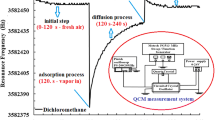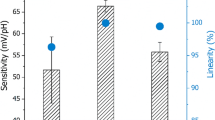Abstract
A new method for investigation of the swelling of polymers on exposure to gas or vapour has been devised and tested. It uses an optical profilometer (based on the chromatic aberration of a lens system) which is integrated into a computer-controlled gas-dosing and mixing setup. Gas and/or vapour concentration-dependent measurements have been carried out for thick layers of the polymers commonly used in gravimetric and capacitive gas sensors: poly(acrylic acid) (PAA), poly(vinyl pyrrolidone) (PVP), poly(ether urethane) (PEUT), and polydimethylsiloxane (PDMS). The thickness of PAA, PVP, and PEUT films changed significantly on exposure to humidity. These data have been used to derive the sorption isotherms of the respective polymers, which were found to be Henry or Flory–Huggins isotherms. Comparison of the geometrical (swelling) responses with capacitive responses revealed a strong correlation. The correlation, which occurs because both types of response are proportional to the water content of the polymer, is also valid for polymers with nonlinear gas responses. Finally the geometrical and electrical characteristics of the capacitive samples were used to explain the dependence of the capacitive response of different polymers on the concentration of the target gas or vapour. In this way was deduced that PDMS, which does not swell on exposure to humidity, swells in the presence of 2,3-dimethylpentane, for which no profilometer evaluations are yet available.






Similar content being viewed by others
References
Oprea A, Courbat J, Bârsan N, Briand D, De Rooij NF, Weimar U (2009) Temperature, humidity and gas sensors integrated on plastic foil for low power applications. Sensors Actuators B Chem 140:227–232
Mujahid A, Keppler M, Lieberzeit PA, Dickert FL (2011) From mono- to polytopic interactions via hydrogen bonds — Capacitive sensor studies. Mater Sci Eng C 31:553–557
Kummer AM, Hierlemann A, Baltes H (2004) Tuning sensitivity and selectivity of complementary metal oxide semiconductor-based capacitive chemical microsensors. Anal Chem 76:2470–2477
Potyrailo RA, Burns A, Surman C, Lee DJ, McGinniss E (2012) Multivariable passive RFID vapor sensors: roll-to-roll fabrication on a flexible substrate. Analyst 137:2777–2781
Oikonomou P, Patsis GP, Botsialas A, Manoli K, Goustouridis D, Pantazis NA, Kavadias A, Valamontes E, Ganetsos T, Sanopoulou M et al (2011) Performance simulation, realization and evaluation of capacitive sensor arrays for the real time detection of volatile organic compounds. Microelectron Eng 88:2359–2363
Igreja R, Dias CJ (2006) Dielectric response of interdigital chemocapacitors: The role of the sensitive layer thickness. Sensors Actuators B Chem 115:69–78
Beyerlein D, Belge G, Eichhorn K-J, Gauglitz G, Grundke K, Voit B (2001) Preparation and properties of thin films of hyperbranched polyesters with different end groups. Macromol Symp 164:117–132
Biesalski M, Johannsmann D, Rühe J (2002) Synthesis and swelling behavior of a weak polyacid brush. J Chem Phys AIP 117:4988–4994
Manoli K, Goustouridis D, Chatzandroulis S, Raptis I, Valamontes ES, Sanopoulou M (2006) Vapor sorption in thin supported polymer films studied by white light interferometry. Polymer 47:6117–6122
Barsan N, Koziej D, Weimar U (2007) Metal oxide-based gas sensor research: How to? Sensors Actuators B Chem 121:18–35
Altenberend U, Oprea A, Barsan N, Weimar U (2011) Untersuchung der Schichtdickenänderung dicker Polymerschichten geeignet für kapazitive Gassensoren. In: Gerlach G, Schütze A (eds) Dresdner Beiträge zur Sensorik: 10. Dresdner Sensor-Symposium 43:249–252
Sahm M, Oprea A, Barsan N, Weimar U (2008) Interdependence of ammonia and water sorption in polyacrylic acid layers. Sensor Actuat B-Chem 130:502–507
Oprea A, Bârsan N, Weimar U, Bauersfeld ML, Ebling D, Wallenstein J (2008) Capacitive humidity sensors on flexible RFID labels. Sensors Actuators B Chem 132:404–410
Belge G, Beyerlein D, Betsch C, Eichhorn KJ, Gauglitz G, Grundke K, Voit B (2002) Suitability of hyperbranched polyester for sensoric applications - investigation with reflectometric interferance spectroscopy. Anal Bioanal Chem 374:403–411
Briand D, Oprea A, Courbat J, Barsan N (2011) Making environmental sensors on plastic foil. Mater Today 14:416–423
Igreja R, Dias CJ (2004) Analytical evaluation of the interdigital electrodes capacitance for a multi-layered structure. Sensors Actuators A Phys 112:291–301
Oprea A, Bârsan N, Weimar U (2009) Work function changes in gas sensitive materials: Fundamentals and applications. Sensors Actuators B Chem 142:470–493
JLM Innovation - Sensor Systems and Sensor Networks. http://www.jlm-innovation.de/
Lee JN, Park C, Whitesides GM (2003) Solvent Compatibility of Poly(dimethylsiloxane)-Based Microfluidic Devices. Anal Chem 75:6544–6554
Buckley DJ, Berger M, Poller D (1962) The swelling of polymer systems in solvents. I. Method for obtaining complete swelling–time curves. J Polym Sci 56:163–174
Kaspar S, Rathgeb F, Nopper D, Gauglitz G (1999) Influence of relative humidity in sensing halogenated hydrocarbons with Reflectometric Interference Spectroscopy (RIfS). Fresen J Anal Chem 363:193–196
Altenberend U, Molina-Lopez F, Oprea A, Briand D, Bârsan N, Rooij NF De, Weimar U (2012) Towards fully printed capacitive gas sensors on flexible PET substrates based on Ag interdigitated transducers with increased stability. Sensor Actuat B-Chem doi:10.1016/j.snb.2012.11.025
Biesalski M, Rühe J (2000) Swelling of a Polyelectrolyte Brush in Humid Air. Langmuir 16:1943–1950
Süvegh K, Zelkó R (2002) Physical Aging of Poly(vinylpyrrolidone) under Different Humidity Conditions. Macromolecules 35:795–800
Fischer F, Bauer S (2009) Polyvinylpyrrolidon. Ein Tausendsassa in der Chemie. Chemie in unserer Zeit 43:376–383
Hörter M (2008) Influence of ammonia and water sorption on the chemical and electrochemical properties of polyacrylic acid and its derivates. Eberhard-Karls Universität Tübingen
Hoerter M, Oprea A, Bârsan N, Weimar U (2008) Chemical interaction of gaseous ammonia and water vapour with polyacrylic acid layers. Sensors Actuators B Chem 134:743–749
Oikonomou P, Botsialas A, Manoli K, Goustouridis D, Valamontes E, Sanopoulou M, Raptis I, Patsis GP (2012) Chemocapacitor performance modeling by means of polymer swelling optical measurements. Sensors Actuators B Chem 171–172:409–415
Oikonomou P, Salapatas A, Manoli K, Misiakos K, Goustouridis D, Valamontes E, Sanopoulou M, Raptis I, Patsis GP (2011) Chemocapacitance response simulation through polymer swelling and capacitor modeling. Procedia Eng 25:423–426
Kummer AM, Burg TP, Hierlemann A (2006) Transient signal analysis using complementary metal oxide semiconductor capacitive chemical microsensors. Anal Chem 78:279–290
Bruggeman DAG (1935) Berechnung verschiedener physikalischer Konstanten von heterogenen Substanzen. I. Dielektrizitätskonstanten und Leitfähigkeiten der Mischkörper aus isotropen Substanzen. Ann Phys 416:636–664, WILEY-VCH Verlag
Landauer R (1952) The Electrical Resistance of Binary Metallic Mixtures. J Appl Phys 23:779
Van Gerwen P, Laureyn W, Laureys W, Huyberechts G, Op De Beeck M, Baert K, Suls J, Sansen W, Jacobs P, Hermans L et al (1998) Nanoscaled interdigitated electrode arrays for biochemical sensors. Sensors Actuators B Chem 49:73–80
Acknowledgments
The authors gratefully acknowledge support from EPFL-SAMLAB, Neuchatel, the group of Danick Briand, who provided the capacitive transducers used in the capacitance experiments.
Author information
Authors and Affiliations
Corresponding author
Additional information
This paper is dedicated to Professor Franz Dickert on the occasion of his 70th birthday.
Appendix 1
Appendix 1
Effect of the geometry of an interdigitated structure on its capacitance
Explanation of why the capacitive sensitivity of an interdigitated structure depends on the interdigital ratio, r, is related to the geometry of the capacitive transducer and to field distribution. Dissimilar to a plane parallel capacitor, for which, in practice, all the electrical field lines are confined between the electrodes, for interdigitated capacitive transducers the field lines are, more or less, perpendicular to the transducer surface, filling the space above the electrodes up to a height no larger than the interdigital semi-period [16, 33]. The geometrical capacitance of the transducer is the capacitance measured with no additional dielectric layer on top (and has the value associated with an air column of height 0.5 λ and a dielectric constant of 1). Deposition of a polymer layer divides the sample capacitance into two components, that of the polymer (of height L and polymer dielectric constant >1) and that of the air (of height 0.5 λ − L and dielectric constant 1) which combine together (parallel and partially serial distributed connection) to give the actual sample capacitance. The higher (thicker) the polymer layer the larger is its contribution to the total capacitance of the sample and, as a consequence, its capacitive sensitivity to gases. Additionally, the polymer swelling, equivalent to an increase in L, will always result in a positive capacitance change if L is no larger than 0.5 λ and will have almost no effect for L > 0.5 λ.
Rights and permissions
About this article
Cite this article
Altenberend, U., Oprea, A., Barsan, N. et al. Contribution of polymeric swelling to the overall response of capacitive gas sensors. Anal Bioanal Chem 405, 6445–6452 (2013). https://doi.org/10.1007/s00216-013-7023-x
Received:
Revised:
Accepted:
Published:
Issue Date:
DOI: https://doi.org/10.1007/s00216-013-7023-x




